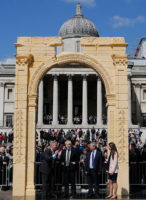The magnificent archeological ruins of Palmyra, Syria—whose rediscovery by travelers in the 17th century contributed to the revival of Greco-Roman architecture in the West—are being systematically destroyed by Islamic State militants. The group has already obliterated some of the site’s most significant buildings.
In detonating the treasures at the site northeast of Damascus, the Islamic State of Iraq and Syria (ISIS) is targeting the antithesis of its purist identity as the self-designated restorer of the caliphate: an ancient city that during the first to third centuries CE was a multicultural, multiethnic, multireligious, and multilingual society whose architecture uniquely fused classical with Persian and Mesopotamian influences.
“What we’ve lost is one of the best-preserved Greco-Roman sites in the eastern part of the Roman Empire,” says Michael Danti, academic director of the Syrian Heritage Initiative of the American Schools of Oriental Research (ASOR). “It’s a hybrid site—a rare example of fusion of multiple cultural influences, and it was literally the site where for centuries east met west on the great Silk Road. That’s why it was so important to Greece and Rome, and to the people of Persia, Iraq, and Syria.”
The style of the monuments and tombs of Palmyra was widely imitated during the classical revival primarily in 18th-century Britain, but also the rest of Europe, Danti says.
ISIS, seeking to demonstrate its power and win recruits, has not only destroyed the architecture of this UNESCO World Heritage site, it murdered its Syrian curator, 82-year-old Khaled al-Asaad, who had devoted his life to the study of Palmyra. According to relatives, his corpse was mutilated. ISIS also transformed Palmyra’s second-century Roman amphitheater into a showcase for its cruelty by publicly executing 25 regime soldiers and allied fighters there.
The destruction of what scholars consider to be Palmyra’s most significant building, the Temple of Bel (confirmed by satellite imagery on September 2), was immense: only the front gateway of the inner cella was left standing. The temple, which dates to the first century CE, was termed by UNESCO “a remarkable fusion of the architectural styles of the ancient Near East and the Greco-Roman tradition, visible in its sculptured ceilings, monumental podium and friezes, which told the story of the city and featured camel caravans and the constellations.”
Ross Burns, adjunct professor of ancient history at Macquarie University in Sydney, adds that its intact condition, size, and sheer beauty made it the most important Roman structure in Syria. “It’s exemplary of Roman building of large temple complexes on the scale of the Jerusalem temple,” he told RECORD. “We don’t have any remains of the Jerusalem temple shrine itself, but we did of the Palmyra one.”
Danti says Bel embodied
all that was precious about
Palmyra. “It is laid out like a
Syrian or Mesopotamian
temple—the plan goes back
to much earlier temples from the Middle East. It’s a Semitic plan, but the style is Greco-Roman in terms of its colonnades, its entablature, and the carvings.”
Bel’s destruction followed the obliteration of the first classical target in Palmyra (ISIS has also destroyed Shiite and Sufi Muslim shrines and, in a neighboring village, the remains of a Byzantine monastery still used for prayer), a temple to a different god, Baalshamin, the lord of the heavens in the Canaanite pantheon. An ASOR report shows satellite imagery from August 27 confirming the destruction. According to Burns, the earliest remains dated to 17 CE, though the majority of the structure dated to the early second century CE. The Temple of Baalshamin was a blend of Roman and ancient Syrian styles with Egyptian influences, something that in ASOR’s view made it unique in Syria. In his book Monuments of Syria: an Historical Guide, Burns describes the style of the central exedra as “almost fanciful or baroque.” The cella, he noted, was preceded by a six-columned vestibule and the side walls decorated with Corinthian-order pilasters.
Between the end of June and the beginning of September, ISIS also severely damaged or destroyed seven of Palmyra’s famous tower tombs, tall multistory sandstone buildings used for burial by the city’s richest families. Prominent among those destroyed was the Tower of Elahbel, whose front had an arch with a sarcophagus that had supported a reclining statue and whose rooms were divided by colorful bays of niches.
Disturbing though the destruction of the world’s architectural heritage is, the danger to human lives is worse. Danti says, “The people trapped in Palmyra, that’s what’s really on my mind. I do my job as a heritage expert and remain objective,” he says. “But I worked for 20 years in Syria, and my mind is on my friends and colleagues who were so welcoming and kind to us and are now at the mercy of the Islamic State and other organizations.’”




